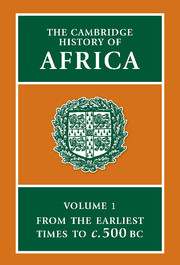Book contents
- Frontmatter
- 1 The palaeo-ecology of the African continent: the physical environment of Africa from earliest geological to Later Stone Age times
- 2 Origins and evolution of African Hominidae
- 3 The earliest archaeological traces
- 4 The cultures of the Middle Palaeolithic/Middle Stone Age
- 5 The Late Palaeolithic and Epi-Palaeolithic of northern Africa
- 6 The Later Stone Age in sub-Saharan Africa
- 7 The rise of civilization in Egypt
- 8 Beginnings of pastoralism and cultivation in north-west Africa and the Sahara: origins of the Berbers
- 9 The origins of indigenous African agriculture
- 10 Old Kingdom, Middle Kingdom and Second Intermediate Period in Egypt
- 11 Early food production in sub-Saharan Africa
- 12 Egypt, 1552–664 BC
- Bibliographical essays
- Bibliography
- Index
- Fig. 3.5 The distribution of sites known or believed to be older than 1.5 million years (i.e. Oldowan). (Modified from J. D. Clark 1967.)
- Fig. 3.6 The distribution of sites known or believed to be between 1.5 and 0.7 million years (i.e. Early Acheulian and Developed Oldowan).">
- Fig. 3.7 The location of Earlier Stone Age and Lower Palaeolithic sites thought to be between 0.7 and 0.1 million years old (i.e. Acheulian plus Developed Oldowan/Hope Fountain).
- Fig. 3.16 The ‘Zinjanthropus’ site at FLK, Bed I, Olduvai Gorge. A plan showing the distribution of an old ground–surface which was uncovered by excavation. A dense patch of discarded artifacts and introduced stones (manuports) coincides with a dense patch of broken–up animal bones. (After M. D. Leakey 1971.)
- Plate Section
- Plate Section
- Plate Section
- Plate Section">
- Plate Section
- Plate Section
- Plate Section
- References
5 - The Late Palaeolithic and Epi-Palaeolithic of northern Africa
Published online by Cambridge University Press: 28 March 2008
- Frontmatter
- 1 The palaeo-ecology of the African continent: the physical environment of Africa from earliest geological to Later Stone Age times
- 2 Origins and evolution of African Hominidae
- 3 The earliest archaeological traces
- 4 The cultures of the Middle Palaeolithic/Middle Stone Age
- 5 The Late Palaeolithic and Epi-Palaeolithic of northern Africa
- 6 The Later Stone Age in sub-Saharan Africa
- 7 The rise of civilization in Egypt
- 8 Beginnings of pastoralism and cultivation in north-west Africa and the Sahara: origins of the Berbers
- 9 The origins of indigenous African agriculture
- 10 Old Kingdom, Middle Kingdom and Second Intermediate Period in Egypt
- 11 Early food production in sub-Saharan Africa
- 12 Egypt, 1552–664 BC
- Bibliographical essays
- Bibliography
- Index
- Fig. 3.5 The distribution of sites known or believed to be older than 1.5 million years (i.e. Oldowan). (Modified from J. D. Clark 1967.)
- Fig. 3.6 The distribution of sites known or believed to be between 1.5 and 0.7 million years (i.e. Early Acheulian and Developed Oldowan).">
- Fig. 3.7 The location of Earlier Stone Age and Lower Palaeolithic sites thought to be between 0.7 and 0.1 million years old (i.e. Acheulian plus Developed Oldowan/Hope Fountain).
- Fig. 3.16 The ‘Zinjanthropus’ site at FLK, Bed I, Olduvai Gorge. A plan showing the distribution of an old ground–surface which was uncovered by excavation. A dense patch of discarded artifacts and introduced stones (manuports) coincides with a dense patch of broken–up animal bones. (After M. D. Leakey 1971.)
- Plate Section
- Plate Section
- Plate Section
- Plate Section">
- Plate Section
- Plate Section
- Plate Section
- References
Summary
INTRODUCTION
Most of the geographical area considered in this chapter falls into what is sometimes called ‘white Africa’, where much of the modern population is more closely related, culturally and biologically, to the south-west Asian and circum-Mediterranean peoples than to those south of the Sahara. There are obvious geographical and historical reasons for these physical, religious and linguistic similarities in recent times. It is probable that an analogous situation existed during the period of prehistory discussed here, but it is difficult to measure the extent of the relationships. Although never sealed off from the regions south of the deserts, and at times even enjoying considerable cultural and genetic exchanges with them, northern Africa nevertheless remained a sub-region of Africa that was marked by its ties with the lands to the east, and perhaps to the north, of the Mediterranean. The cultural features during the Late Palaeolithic and Epi-Palaeolithic were therefore the products, on the one hand, of influences from outside the area and, on the other, of prolonged selection and sorting of various elements by human adaptive strategies suitable to the physical features and the resources peculiar to the local environments within North Africa.
The area involved is very large and extends from the Atlantic to the Red Sea and from the Mediterranean to the southern part of the Sahara (fig. 5.1). This southern boundary is difficult to fix with precision, but it can be considered to correspond approximately to latitude 16°N and thus to run from about Dakar to Khartoum and eastward to the Red Sea, cutting across the republics of Senegal, Mauritania, Mali, Niger, Tchad and Sudan.
Keywords
- Type
- Chapter
- Information
- The Cambridge History of Africa , pp. 342 - 409Publisher: Cambridge University PressPrint publication year: 1982
References
- 4
- Cited by



